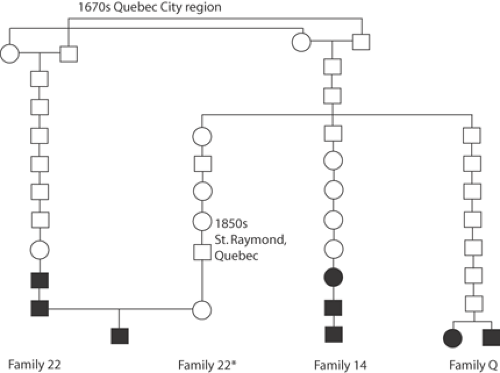Familial Partial (Focal) Epilepsy With Variable Foci
Eliane Kobayashi
Frédérick Andermann
Eva Andermann
Introduction
Familial partial (focal) epilepsy with variable foci (FPEVF) is a distinct syndrome among the familial partial epilepsies, in that different clinical and electroencephalographic (EEG) features can be observed in different family members, suggesting that different epileptic foci may be determined by the same genetic mutation. On the other hand, the epileptic focus in any one individual remains the same.
Recently, FPEVF was included in the new diagnostic scheme for epileptic syndromes proposed by the International League Against Epilepsy (ILAE). Although it is displayed as a syndrome in development, this inclusion supports its uniqueness.8
Historical Perspectives
FPEVF is a unique syndrome first reported in 1998 in an Australian kindred by Scheffer et al,28 and in the following year in two French–Canadian kindreds by Xiong et al.36 Other more homogeneous familial partial epilepsy syndromes, including autosomal-dominant nocturnal frontal lobe epilepsy (ADNFLE),27 familial temporal lobe epilepsy (FTLE),1a,2 and autosomal-dominant partial epilepsy with auditory features (ADPEAF)21 had been described (reviewed in Andermann et al.1). To date, only 10 pedigrees of FPEVF have been identified and reported in the literature.3,4,25,28,35,36
Definitions
Due to its uniqueness, FPEVF can only be defined on the basis of family rather than individual phenotypes. The occurrence of at least two different partial epilepsy syndromes in first- and second-degree relatives with no identifiable structural brain abnormality and segregating in a sufficient number of individuals in more than one generation is suggestive of FPEVF. Nevertheless, it has to be highlighted that, since the first report by Scheffer and colleagues,28 many small families have been ascertained that could indeed have represented FPEVF, but both the diagnosis and the inheritance pattern could not be definitely confirmed.
Epidemiology
FPEVF kindreds have been identified in Australia, Canada, Spain, Holland and other European countries. Three of the 10 families are French-Canadian, originating from the region around Quebec City and sharing the same haplotype on chromosome (chr) 22q, suggesting a founder effect (Figs. 1 and 2).3,35 FIGURE 2 demonstrates that a Spanish family has a completely different haplotyes than the French-Canadian families. Several small families have also been identified in the Eastern Townships region of Quebec, where linkage to the same region on chr22 is suggested, but these families have a different haplotype (P. Cossette, personal communication). Another Spanish family, which links to chr22, has also been described.19 This family originates from a different region of Spain and has a different haplotype from the first Spanish family (J. Serratosa, personal communication).
Due to the variable seizure pattern among affected family members and the usually benign clinical outcome, FPEVF might often be underdiagnosed, as is the case for other familial partial epilepsy syndromes. It seems to be less frequent than other familial partial epilepsies, but, in the absence of genetic confirmation, it is impossible to estimate its frequency at present.
Etiology and Basic Mechanisms
In terms of etiology, it should again be emphasized that only 10 pedigrees have been reported in the literature.3,4,25,28,35,36 All are compatible with an autosomal-dominant inheritance pattern with approximately 70% penetrance. Two different loci have been associated with FPEVF, the first with suggestive linkage on chr 2q,28 and the second on chr 22q.36 However, the gene(s) have not been cloned. Only one reported kindred had suggestive linkage to chr 2q,28 but the family was not large enough to confirm linkage. Although linkage to chr 22q has now been confirmed in six families,3,4,19,35,36 the gene has not been identified. Sequencing with mutation analysis has excluded the coding regions of >60 genes in the region on chr22q (A. Kerstin Lindblad-Toh, personal communication).
The mechanisms by which these molecular abnormalities can present as different types of idiopathic partial epilepsy within the same family are intriguing. Modifying genes and environmental factors should be further investigated.
Clinical Presentation
In FPEVF, affected family members may present with different types of partial epilepsy, which are, however, invariable within each subject. Frontal lobe seizures are the most frequent manifestation, but they have a different pattern in FPEVF as compared to that observed in ADNFLE (Table 1): The seizures are less frequent, clusters and auras are rare, and daytime seizures as well as secondarily generalized seizures are more frequent.3 Age at seizure onset is variable; onset usually occurs in the first three decades, with two peaks at approximately 5 and 25 years of age.35,36 Although temporal lobe seizures are also commonly found, centroparietal and occipital seizures are less frequent. There is also marked intrafamilial heterogeneity in seizure severity and outcome.
 FIGURE 1. Genealogic representation of three French-Canadian families (F22, F22*, F14) demonstrating a founder effect. |
Stay updated, free articles. Join our Telegram channel

Full access? Get Clinical Tree






